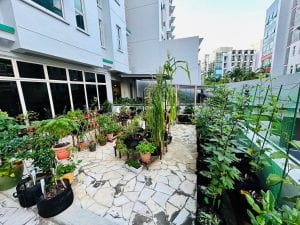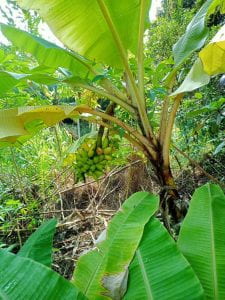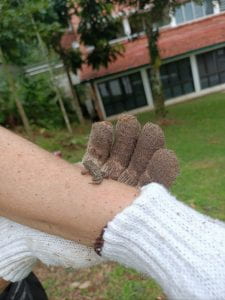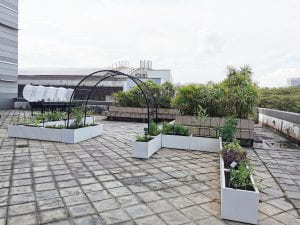From weeding to watering, there is a job for everyone at community gardens. These green patches set in urban environments, sometimes small and sometimes big, are bringing resident communities across the world local produce, emotional wellbeing and a revitalised connection to nature.
While the origins of community gardening can be traced back to the 18th and 19th centuries in Europe, urban gardening is relatively new to Singapore. The 1967 “Garden City” movement and the more recent “Community In Bloom” initiative (2005) by the National Parks Board (NParks) have played an important role in encouraging Singaporeans to get their gardening shovels and watering cans out. More recently, Singaporean youth have become increasingly involved in greening efforts as they become pioneering voices in sustainability and climate change related issues.
Our resident community here at NUS, too, has been getting its hands dirty at the numerous community garden spaces on campus. While some gardens are well established and some are brand new, both come with their own sets of hurdles and rewarding learning experiences.
Setting up a new community garden can indeed be challenging. “There are a lot of ups and downs,” shared Mr. Yuzuru Hamasaki, a Japanese Language lecturer at NUS and a resident fellow at Prince George’s Park Residences (PGPR). When he joined PGPR the previous year, Mr. Hamasaki took charge of setting up a community garden there. After setting up a Green Committee consisting of resident students, Mr. Hamasaki and his team began brainstorming design ideas for the gardening space they were allotted.
Community gardens, as the name suggests, are community-oriented and should deeply involve the community to be successful and sustainable in the long run. Understanding this, the team then sent out a survey to PGPR residents asking them what sort of plants they would like to see in the upcoming garden. Once the garden’s design and plants were confirmed, the team got busy with placing orders and assembling items.
The new PGPR community garden at Block 10, Level 1 balcony
But the work didn’t end there. Currently, the committee is busy experimenting with their plants and gardening techniques. The garden (now named The Green Corner @ PGP by PGPR residents after a garden naming contest) includes a hydroponics and aeroponics section alongside traditional soil gardening. The Green Committee has been learning what works and what doesn’t work in the Singaporean tropical climate through lots of trial and error. “We’ve killed quite a few plants,” chuckled Mr. Hamasaki during our interview.
But the excitement of seeing plants that you have cared for grow successfully is unparalleled. It’s all worth it when you can see that “the plant has made it!” remarked Ayushi Marwah (Y3, Economics), an international student residing in PGPR and a member of the Green Committee. Jai Lal Lulla (Y4, Computer Science) and Atin Sakkeer Hussain (Y4, Computer Science), international students also part of the committee, described their time working at the PGPR garden as relaxing and fulfilling.
These students have been incorporating knowledge gained from watching family members grow herbs and edibles back home, into the new garden at PGPR. For Mr. Hamasaki, Ayushi, Atin, Jai and the other committee members, the community garden has been a safe space to grow and learn from each other. Communication in community gardens is a two-way street and collaboration is key.
PGPR residents can look forward to joining the interest group “Green Team” once the new academic year starts. The garden, located at the Block 10 balcony, is now open to residents, so feel free to drop by when you need a break after a long day!
See here for a short clip of the Green Committee carrying out an indoor aeroponics trial.
Other community gardens have been around for a while. Residents at Raffles Hall (RH), for example, have been gardening on two plots for some years now. Over the years, the RH Green Committee has cultivated a wide variety of plants from sugarcane (yes, sugarcane!) to chillis to bananas. “Our seniors once used pandan from our garden to cook the broth for tang yuan dumplings,” shared Ng Chuan Xin (Y2, Computer Science), head of gardening at Raffles Hall.
A major factor in determining a plant’s success seems to be the oh-so-hotly-discussed Singaporean climate – sometimes hot and humid, and at other times rainy. Some plants such as lavender, unfortunately did not survive the humidity, while others, such as the butterfly pea flower, are thriving in the RH gardens.
Student involvement and enthusiasm have been crucial in ensuring the garden’s continuity. During the academic year, Green Committee members take weekly shifts maintaining the plots. There are unofficial members who are simply interested in gardening joining the regular gardeners, too. Some dedicated students even come down during the semester breaks to do some upkeep work.
Big smiles after a rewarding day at the RH community garden
When asked why she thinks community garden spaces are important on university campuses, Goh Ler Xuan (Y2, Computer Science), the current head of RH Green Committee observed, “Community gardening is a great chance to bond with each other and get to know the nature [around].”
Check out more photos of the RH community garden on their website here.
We also reached out to Ridge View Residential College (RVRC), to hear about their community garden spread over three plots. RVRC, the only residential college located outside UTown and within the Kent Ridge campus, calls itself the “College in Nature” and places a large emphasis on sustainability. As such, their community gardening initiative, headed by the RV Green Rangers interest group, was initiated some years ago with a focus on food sustainability and farming edibles.
Since last year, they’ve been focusing on three aspects: gardening for food, gardening for wildlife and gardening for physical & emotional wellbeing. Gardening for food involves growing edible food. Gardening for wildlife aims to attract wildlife such as birds and butterflies. Gardening for physical & emotional wellbeing acknowledges the immense health benefits that come with being in touch with nature.
During our interview with Ms. Patricia Lorenz – an RVRC fellow, nature enthusiast and advisor to the RV Green Rangers – many gardening gems were dropped generously. If you are a new gardener or thinking of taking up gardening, get your notebook ready!
Challenge: A challenge of gardening edibles in Singapore is the lack of healthy topsoil in Singapore. Topsoil, the upper most layer of soil, contains the most organic material and nutrients, making it important for gardening and farming. While one may be led to believe that a green city that was once dense forest such as Singapore would have an abundance of healthy topsoil, that does not seem to be the case. Tropical forests, interestingly, have thin and poor topsoil. Where do trees then gather nutrients from? The leaf litter. And on cleared land, leaf litter is no longer present and so the topsoil is quickly depleted. How can we grow edibles on such land?
Solution: This is where raised beds come in. By building raised beds, it’s possible to segregate an area of rich soil and mulch to plant edibles in. While wooden planks can also be used to create the enclosure, in Singapore they decay quickly and red bricks are a smarter option. RVRC hopes to install a raised bed this coming academic year and we can’t wait!
An example of a raised bed (Source: trulyhandpicked.com)
Challenge: Wildlife gardening can be exciting and new terrain for many. One increasingly popular concept is that of butterfly gardens. However, planting just flowering plants is not enough to attract these beautiful insects. How do you create a successful butterfly garden?
Solution: Butterfly gardens require both host plants and food plants. Host plants are the plants caterpillars feed on, whereas food plants are what adult butterflies feed on. Many gardeners will fill up their butterfly gardens with flowering plants (food plants), forgetting that to attract butterflies, you need host plants too. Different butterfly species feed exclusively on specific host plants and this is important to take note of too.
A baby Asian toad found while gardening at the RVRC community garden
Challenge: Growing up in HDB apartments, most Singaporeans are unfamiliar with touching dirt and soil. In our society, soil is often portrayed as being unhygienic and dangerous. Think of all the TV ads you saw growing up where children came home with stain marks from playing outside and the detergent washed off 99% of the germs. This mentality poses a barrier to getting students involved with gardening initially. There is also a fear of failure and reluctance that stems from little-know how on gardening.
Solution: The solution is to educate ourselves. Working with soil results in Earthing: a process by which your bodily charges are neutralised. Being in touch with nature is incredibly healing and an instant mood up-lifter. Many of us today are hugely disconnected from nature, and community gardens are powerful spaces that help to bridge that gap. Since last year, RVRC has been implementing a tree planting session in their Freshmen Orientation Programme, giving all incoming RVRC students a taste of what it’s like to work with soil.
A lot of community gardens in NUS are geared towards student communities residing on campus. But certainly, our staff deserve some respite too! NUS Medicine recently inaugurated a community garden in the MD11 block for academic, executive and administrative staff to come together.
Their garden consists of three sections: the Marketplace, Kampong Memories and Wild Forest. The Marketplace holds plants that are commonly seen in the market that most Singaporeans are familiar with, like the laksa leaf. The Kampong Memories section takes us back to the good old days by growing plants that were commonly eaten in the kampong, such as ulam raja. The Wild Forest section is perhaps the most intriguing. It hosts plants that are commonly seen growing outside but many people are not aware of their edibility, like senduduk.
The Medicine garden is part of a larger initiative to make the campus space greener while also providing a healthy space for the Medicine community to build personal relationships outside of work. Ms. Revathy, a staff member who is overlooking the garden project, hopes that the community garden becomes a place to “thought-share”, sharing ideas across disciplines and personal interests. We hope so too!
The NUS Medicine garden provides a green break after a long day of cognitive fatigue
Phew! We’ve done so much gardening talk. All we see is green. Community gardening is a creative avenue to build social cohesion and lay the foundations for a stronger connection with nature. With the industrialisation of food production, most of us are removed from how our food is produced. And it is costing the planet. A lot. And fast.
Some things may change if people become closer to nature and experience its magic for themselves. We’ll leave you with what Ms. Lorenz told us, “Growing food is an added advantage. But really, the biggest gain is the connection to the food that we eat and the emotional wellbeing.” And we couldn’t agree more.








